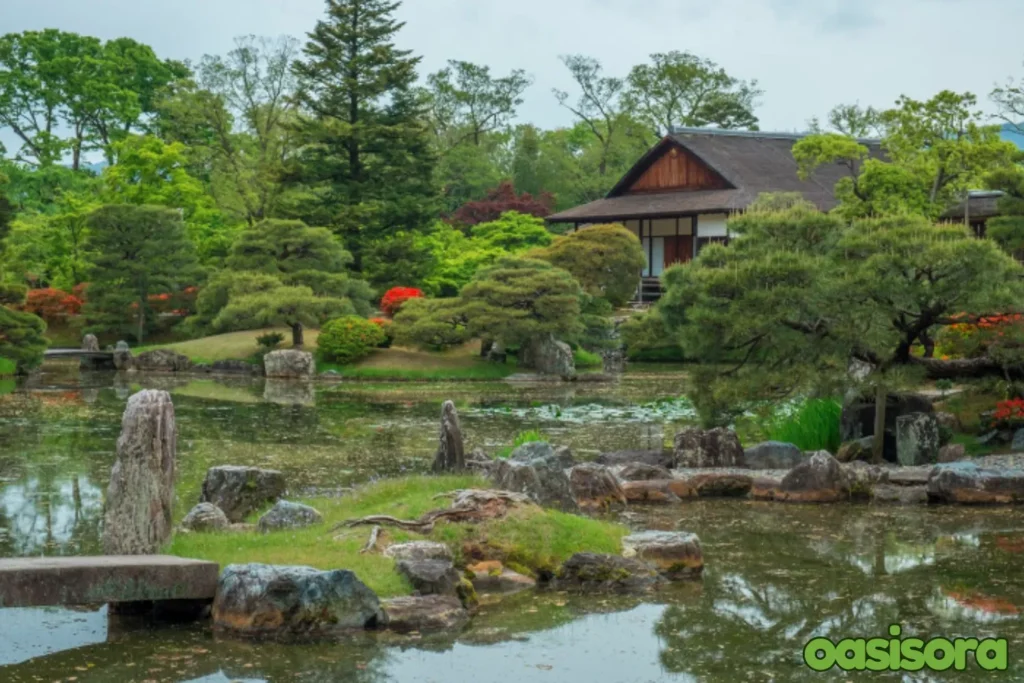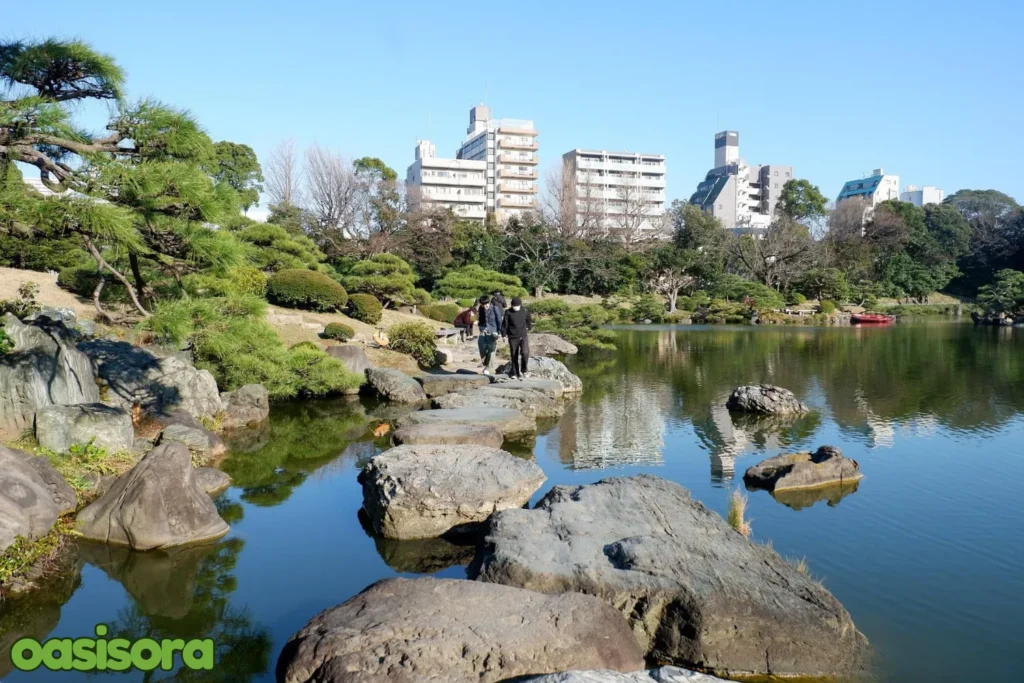
Japanese gardens are very close to peace and nature. All elements of a Japanese garden have a deep meaning and balance between nature and design. Rocks, water, trees, and bridges not only made gardens beautiful but they also represented nature in different ways.
The size of the garden is not a matter of concern. The important thing is Japanese garden beauty and the elements in our small or spacious gardens.
In this article, you will learn about the essential elements of a Japanese Garden and find how they make a peaceful environment in your garden.
What Are the Main Elements of a Japanese Garden?

The gardens at Ginkakuji (The Silver Pavilion)
Some important elements of Japanese gardens help to create a peaceful and balanced environment. They not only represent beauty but also have cultural and spiritual significance in Japan.
Moreover, it is beautiful to see how stone features, water, plants, and bridges all work together to make a healthy environment.
Every element has different meanings for example, rocks can represent mountains, water shows life and movement, and plants bring color and change with seasons.
Water: The Flow of Life and Tranquility

Kenrokuen Garden in Kanazawa
Water is an important element of the Japanese garden. It represents life, purity, and renewal. The presence of water in the Japanese garden brings relaxation.
It can be added as ponds, streams, or waterfalls. These sources increase the sound of water which makes your garden more charming.
Don’t worry if your garden is small; you can easily add water bodies to it. If you place a simple stone basin with running water, it will also give a real feel to your garden.
If your outdoor is big, a pond with koi fish brings color and life, and a stream can also make it more natural.
Stones: Anchoring Stability and Permanence

Ninomaru Garden in Kyoto
Among important elements of the Japanese garden, stones are on top. It represents mountains and islands. These are used to shape the garden and give it a more natural look. Big rocks can be used to show hills, and smaller rocks with soil provide a unique structure to your space.
People can find ways with the help of stepping stones, which make the walk easy and relaxing.
Japanese gardens are not like Western gardens where stones are arranged in perfect symmetry. However, Japanese gardens follow the “wabi-sabi” philosophy of art. This philosophy values natural beauty and imperfection.
For example, stones are set up in a way that makes them look natural. Adding a gravel path or a few rocks in small gardens can make the space feel more durable and bring harmony to the garden.
Lanterns: Symbols of Light and Guidance

Taima-ji style lantern in Okochi Sanso Gardens in Kyoto
Japanese gardens cannot be complete without lanterns. They represent light and guidance. Most people put these lights near water, paths, or tea places to make the area visible and friendly.
These lanterns enhance the beauty and appeal of the garden at night.
Lanterns come in many kinds. Each one has a different breadth, height, and style. However, some look more elegant and tall, and others look simple and short.
If you place a simple stone light near a pond or a path, this can add beauty and depth to a small garden. But don’t focus on the size or style too much because any type of lantern adds a sense of calm and tradition to any space.
Water Basins (Tsukubai): Ritual Cleansing

Kiyosumi Teien Garden in Tokyo
Water basins are also called Tsukubai. They are used in Japanese gardens for purification. In old times, people used to wash their hands and mouths before going into holy areas.
This tradition brings awareness and makes the garden experience respectful. There are different kinds of water basins used in Japanese gardens, like rough stones or hand-carved patterns.
In the past, they were mostly used for ceremonies, but now they are also added for looks. You can also introduce this feature to your home garden with a small stone bowl filled with running water.
It will look beautiful and also give you peace of mind.
Bridges: Pathways to Peace

Beautiful bridge in Kiyosumi Teien Garden in Tokyo
In Japanese gardens, bridges are not only used to cross water but also increase beauty. They represent a journey and change of life.
When you walk on these bridges, you may have different experiences that refresh your soul.
Moreover, it plays a major role in changing your mental state. It is not a big matter whether they are made of wood or stone, bridges help in movement and naturally connect different areas.
In big gardens, bridges go over ponds or streams that give a nice view of the water. You can get the same feel in small gardens. Make the garden look more fascinating by putting stepping stones on a gravel path or dry stream.
Plants: Celebrating Seasonal Beauty

Plants Celebrating Seasonal Beauty
One of the important elements of a Japanese Garden, plants provide the garden texture and color. They are set in the garden according to the seasons and they have a great relationship with nature and help to balance and calm your surroundings.
Trees and grass stay green all year, just like cherry flowers. You might choose low-maintenance plants if you have indoor or tiny gardens. Instance, moss, ferns, or little bonsai trees are excellent choices.
The plus point of these plants is that they don’t need much care.
Koi Fish: Grace and Good Fortune

Koi Fish
Koi fish bring beauty and life to a Japanese garden. They are known for their bright colors and smooth movements. Its presence in the water adds a peaceful touch.
Japanese people believe that koi fish bring happiness, strength, and determination.
It is relaxing to watch them swim. You can look after them quite easily. Their health depends on a clean pond with effective filtration.
They also need a proper diet, and the ponds provide sufficient area for swimming. Koi fish may survive for many years with correct care.
Borrowed Scenery (Shakkei): Expanding Your View

The Golden Pavilion and gardens borrow scenery from the Arashiyama Mountains
The borrowed scenery is also called Shakkei. It is one of the essential elements of a Japanese garden. The purpose of borrowed scenery is to make a garden feel bigger.
It includes views from the outside, like distant mountains, trees, or buildings. Japanese gardens use them as part of the plan to give the garden a feeling of depth and harmony with nature.
You can use this idea in small spaces, too. A nearby tree, a neighbor’s garden, or a beautiful skyline can become part of your view. You can surround your view of the outside world with plants, walls, or windows in the garden.
This creates a natural setup that makes the view better and makes the space more open and connected to its surroundings.
Hills and Mounds: Symbolizing Mountains

Korakuren Garden in Tokyo
There are hills and small rocks that look like mountains in Japanese gardens. They give the environment more depth. A small elevation change can make the garden more interesting and give you new ways to look at it.
This helps it look natural and relaxed, like the Japanese mountains. This helps give it a natural and peaceful look, like the mountains in Japan.
Small gardens do not need big hills to provide the same effect. A soft slope with rocks or plants put with care can add dimension.
You can also make the space feel more alive and connected to nature by covering high areas with moss or dirt so they look like rising hills.
Paths: Guiding the Journey

Kiyosumi Teien Garden in Tokyo
Paths in Japanese gardens are not just to connect different routes, but they create an experience. Through these walkaways, you can see different views and explore the whole garden step by step.
Every path that is made of stepping stones, gravel paths, or grass adds natural beauty and represents the journey of life.
Are you amazed to know that a winding path makes the walk more peaceful than walking straight? Curved paths or stepping stones can create the same effect and make your garden more inviting and perfect to enjoy every moment.
Buildings and Pavilions: Places of Contemplation
Buildings like tea houses and pavilions are important elements of a Japanese garden. They give a spot where people can relax and experience peace.
These buildings are mostly set up where they fit with the scenery. These are great spots for traditional ceremonies or meditation.
You can add a small gazebo or a simple wooden shelter in modern home gardens. They bring the same feeling of peace. Moreover, a shaded corner with a bench or a cozy tea space can be a perfect retreat for relaxation.
The size of these buildings and pavilions does not matter. Their structures help to create a calming atmosphere and make your garden a perfect place of rest and reflection.
Final Thoughts:
Love and Maintenance: Caring for Your Japanese Garden
Your garden needs your love and time, as everything is precious here. You need to take care of it properly. Therefore, regular maintenance is necessary to keep it clean and fresh.
It includes tasks like trimming plants, water cleaning, and moving dirt to help keep the environment close to nature.
Follow these seasonal routines to keep your garden maintained:
- Trim the plants that are getting too big in the spring season.
- In summer, you need to keep water clean and remove fallen leaves from ponds.
- You must level the gravel and clean up paths to maintain a neat look in autumn.
FAQs
How can I create a little Japanese garden?
You can make a small Japanese garden with just a stream, some seasonal plants, and some small rocks.
How do I choose the easiest plants for my Japanese yard?
Bamboo plants, ferns, small trees, and moss are the best. They look great in any garden and are easy to take care of.
How should I layout my house’s Japanese garden?
Sand, pebbles, and a bonsai tree can help to create a small Japanese garden.

1 thought on “10 Best Elements of a Japanese Garden to Create Tranquility”
Comments are closed.